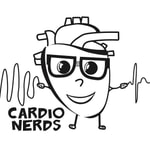Cardionerds: A Cardiology Podcast – Details, episodes & analysis
Podcast details
Technical and general information from the podcast's RSS feed.

Cardionerds: A Cardiology Podcast
CardioNerds
Frequency: 1 episode/5d. Total Eps: 423

Recent rankings
Latest chart positions across Apple Podcasts and Spotify rankings.
Apple Podcasts
🇨🇦 Canada - medicine
02/08/2025#42🇺🇸 USA - medicine
02/08/2025#61🇨🇦 Canada - medicine
01/08/2025#23🇺🇸 USA - medicine
01/08/2025#53🇨🇦 Canada - medicine
31/07/2025#60🇺🇸 USA - medicine
31/07/2025#55🇨🇦 Canada - medicine
30/07/2025#51🇬🇧 Great Britain - medicine
30/07/2025#77🇺🇸 USA - medicine
30/07/2025#49🇨🇦 Canada - medicine
29/07/2025#24
Spotify
No recent rankings available
Shared links between episodes and podcasts
Links found in episode descriptions and other podcasts that share them.
See all- https://youtu.be/BfqnRkaVGkk
1 share
- https://youtu.be/_oYUc-_sdfU
1 share
- https://youtu.be/vVuhUCbqwYk
1 share
RSS feed quality and score
Technical evaluation of the podcast's RSS feed quality and structure.
See allScore global : 48%
Publication history
Monthly episode publishing history over the past years.
388. Ironing out the Data: Iron Deficiency in Heart Failure with Dr. Robert Mentz
mardi 20 août 2024 • Duration 12:28
387. Cardio-Rheumatology: The Role of Inflammation in Cardiovascular Disease with Dr. Antonio Abbate
dimanche 18 août 2024 • Duration 44:29
378. Case Report: Severe Mitral Paravalvular Regurgitation Complicated by Hemolytic Anemia – Duke University
mercredi 26 juin 2024 • Duration 19:36
288. 2nd Annual Sanjay V. Desai Lecture: The Humanity Deficiency in Medicine with Dr. Melanie Sulistio
mardi 18 avril 2023 • Duration 01:09:10
287. Case Report: When Tumors Take Your Breath Away – University of Oklahoma College of Medicine
vendredi 14 avril 2023 • Duration 47:09
286. Guidelines: 2021 ESC Cardiovascular Prevention – Question #21 with Dr. Noreen Nazir
mardi 11 avril 2023 • Duration 07:09
285. Guidelines: 2022 AHA/ACC/HFSA Guideline for the Management of Heart Failure – Question #15 with Dr. Ileana Pina
mardi 11 avril 2023 • Duration 10:57
284. Atrial Fibrillation: Mechanical Stroke Prevention in Atrial Fibrillation with Dr. Christopher Ellis
lundi 10 avril 2023 • Duration 01:03:10
283. CardioNerds Rounds: Challenging Cases – Cardio-Obstetrics and Heart Failure with Dr. Mary Norine (Minnow) Walsh
mercredi 5 avril 2023 • Duration 35:48
282. Guidelines: 2021 ESC Cardiovascular Prevention – Question #20 with Dr. Michael Wesley Milks
mercredi 5 avril 2023 • Duration 13:33









